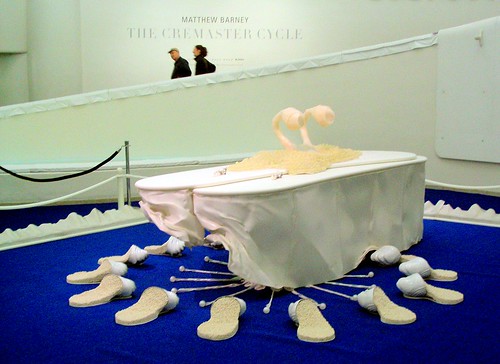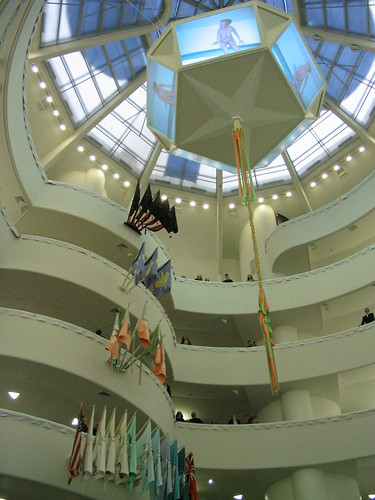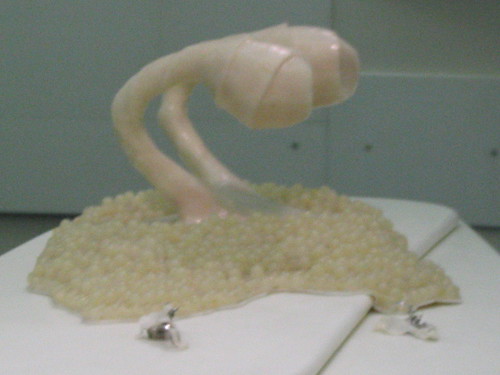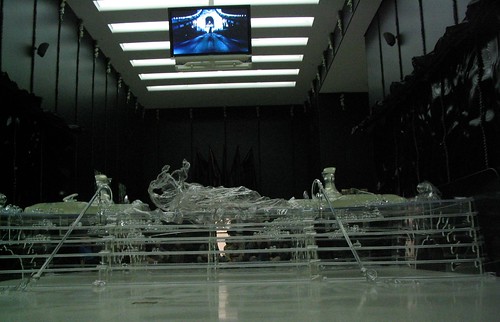Journal of Pirate Lingo*
profile
* not an actual journal
of pirate lingo
|
05.19.06 - 11:31 a.m. 2005-11-08 22:29:00 Thoughts on Matthew Barney
Most of what I know about modern art comes from the one art history class I took in college. It was taught by a brilliant, inscrutable, possibly alcoholic art critic named Thomas McEvilley. McEvilley had written several books, none of which I understood upon a cursory flip-through in the campus bookstore. His lectures happened just once a week, 7-10PM on Friday night. As the hour approached, the class would fill up, but McEvilley was never there early. 5 minutes before class started, he'd emerge, vampire-like, from the shadows near the big slide projection screen. Always on the table before him were two paper cups, which he periodically sipped from throughout the night. One was rumored to contain coffee, the other whiskey. McEvilley was a brilliant, if often incomprehensible, lecturer. He would sit there in the darkness for 3 hours and weave paragraphical commentaries on each of the slides as he clicked through them. With no notes, he was able to extemporanize endlessly and with great eloquence about the "dot-centered quaternity" and other themes woven throughout art history. The early focus on ancient and tribal artwork was dull, but as the class entered modern art it got more interesting. Some of the cool pieces we learned about were:
The class covered movements like Pop Art, Impressionism and Situationism, and it turned me on to a lot of good stuff. But Matthew Barney fell outside what I knew. So when I went into Cremaster Cycle, I didn't have many preconceptions. I had to go more by pure feelings, picking up what context I could from the placards helpfully placed near each piece. (I wonder about art that only makes sense if you read the title / description. Does this reduce to art as joke, placard as punch line?) It was clear that the gatekeepers of New York thought highly of Mr. Barney, because the Guggenheim had given him the entire gallery. It wasn't just a floor devoted to his work; he�d turned the the entire five-floor building into a site-specific installation. Sculptures, paintings and uncategorizable works were everywhere. Huge video projectors above the stairs projected movies recorded within the museum at some previous point. Many of them featured Barney running around dressed up like a caveman (or a fertility god, or something.) As with Janet Cardiff, watching a video that had been filmed exactly where you were produced a delicously odd sensation.
The scope of the Cremaster Cycle was enormous, but the pieces within the museum seemed only tangentially related. Or rather, they were very precisely related, but in a sort of dream logic that was hard to follow. Like the films of David Lynch but with MUCH less plot. In addition to the central film depicting Barney as primordial being climbing up the Guggenheim walls, there were films in which Barney played the role of the infamous Utah serial killer, Gary Gilmore. There were sculptures made out of strange materials-- some resembled waxy, sexualized organs. Surreally, on one floor a huge screen was played footage of a hardcore NYC band performing in the Guggenheim. (How cool would it have been to be there when they recorded that show?) Circles and circles ascending, of ... someone else's dream? Maybe that's what was bothering me. I'm rarely interested in other people's dreams. No matter how vivid or disturbing a dream may seem, when related to others it tends to fizzle & lose its peculiar, psychologically intimate power.
From a craft perspective, I could definitely respect Barney�s abilities. He was adept in seemingly every medium-- sculptures, paintings, photography, textiles, video, acting. He gave some virtuoso performances�as killer, as caveman, as miscellaneous-- but through all this, Matthew Barney himself remained hidden. There was no sense of who he was, or what he believed or what he felt. Thinking back now, it�s clear that I failed to come away from Cremaster Cycle with anything beyond intellectual curiosity. It would be easy to say it doesn�t matter� some pieces just resonate with you emotionally, and others don�t. But the sheer scale of the exhibit, and the accolades Barney had apparently received from all the people who know-- this led me to expect something that would break through the barriers imposed by my lack of knowledge about the scene from which Barney emerged and his history as an artist. The lack of anything breaking through produces the lingering doubt as to whether or not it's a giant case of the emperor having no clothes.
I guess if I�m bothered, it�s only because there are so many artists I do like who don�t get the money or attention that Barney does. I don�t think I�m the only person who left Cremaster Cycle feeling befuddled and untouched. And when you have an experience like this, the danger is that it increases the disconnect you perceive between Art with a capital A and real life. One of the things that I like about modern art that it consciously attempts to break the art/life barrier. Art shouldn�t consist of artifacts to be worshipped in a museum/church. It should be stuff that you can touch and stuff you consider part of your life. Public murals mean more to me than just about any museum painting. The 144 Hearts of San Francisco mean more to me than the most brilliant piece by Rodan. Harrell Fletcher, Andy Goldsworthy, Yoko Ono�- so many of the artists I like make art that either breaks the barrier by being literally outside the musum, or breaks it figuratively by letting you interact. �Painting to hammer a nail in.� If you polled everybody who went to Cremaster Cycle, I think it�s quite possible that the majority of them would say they thought it was interesting but they didn�t really �get� it (or connect with it emotionally). At the same time, it�s entirely possible that if you polled all the professional art critics of the world, they might unanimously proclaim Barney a genius. It�s hard to say how much this disconnect bothers me me. All I know is that art can elevate our lives, and space at the Guggenheim doesn�t come cheap. |



